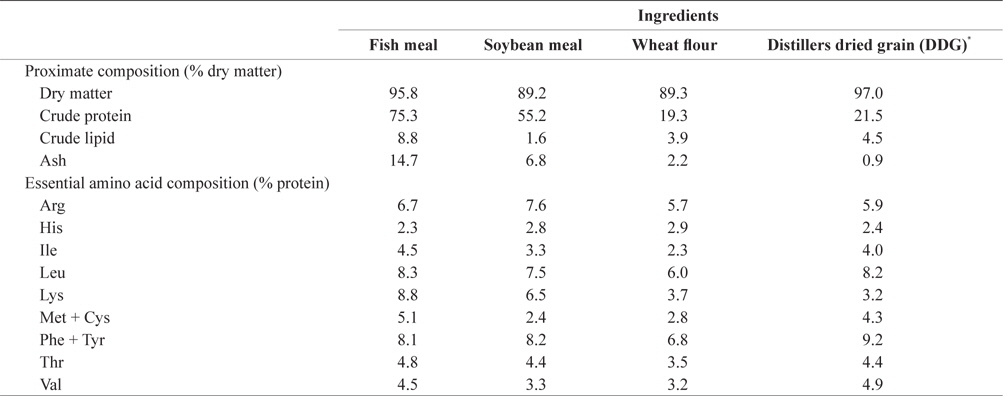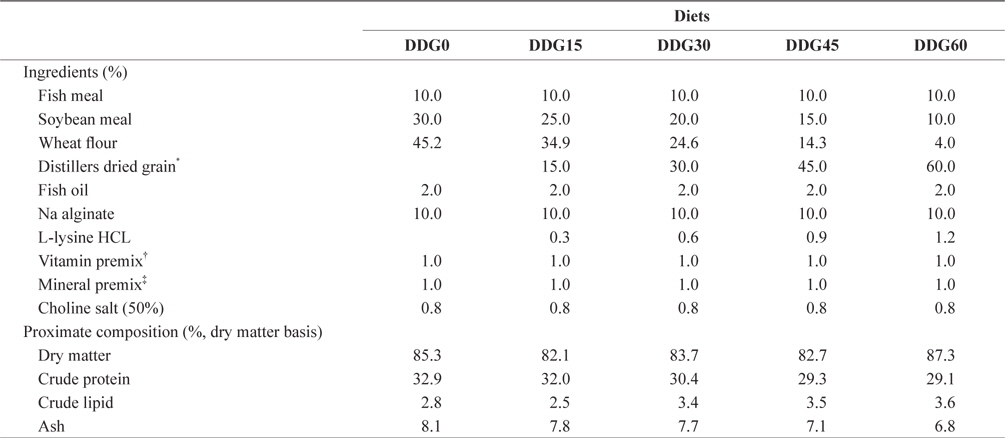



An 8-week feeding experiment was conducted to determine the influence of dietary distillers dried grain (DDG) on the growth and body composition of juvenile abalone Haliotis discus hannai. Five diets were formulated to contain 0% (DDG0), 15% (DDG15), 30% (DDG30), 45% (DDG45), and 60% (DDG60) DDG, and three replicate groups of abalone (average body weight: 3.6 ± 0.21 g) were fed one of the experimental diets at a feeding rate of 5% body weight per day once daily (17:00 h) for 8 weeks. Survival, shell length, and shell width of juvenile abalone were not affected by dietary DDG levels (P > 0.05). Weight gains of juvenile abalone fed DDG15 and DDG30 diets were not different compared to DDG0, but abalone fed DDG45 and DDG60 diets gained less weight than those fed DDG0 (P < 0.05). Soft body weight/body weight ratio of juvenile abalone fed the DDG60 diet was lower than that of those fed the DDG0 diet (P < 0.05), but proximate composition of the soft body was not affected by dietary DDG levels (P > 0.05). The results of this experiment suggest that DDG is a good replacement for wheat flour and soybean meal, and can be used up to 30% in the diet to maintain the growth performance of the juvenile abalone.
Successful operations associated with the aquaculture industry are growing rapidly. Abalone
Distillers dried grain (DDG) is a cereal by-product that is fermented and distilled to create alcoholic beverages (Hertrampf and Piedad-Pascual, 2000). DDG is a useful feed ingredient in the livestock industry because of its high nutritional value and low cost, and it is currently mainly being tested for use as a possible energy source in ruminant diet programs (Jacob et al., 2008). However, due to the enhanced availability and potential cost–benefit of DDG, incorporating DDG into aquafeed may present a large economic value. DDG has already been tested as a possible alternative protein and/or energy source associated with aquafeed (Chevanan et al., 2010; Wu et al., 1996), and it is less expensive than traditional ingredients such as soybean meal and wheat flour (Rahman et al., 2013a, Rahman et al., 2013b). Seo et al. (2011) reported that rice-based DDG contains a high protein content and well-balanced amino acid profile, and may be useful for producing low-cost feed for juvenile olive flounder (Rahman et al., 2013a) and sea cucumber (Choi et al., 2013). Therefore, the objective of the this study was to investigate the effects of dietary DDG as an alternative feed ingredient (compared to traditional soybean meal and wheat flour) on the growth and body composition of juvenile abalone.
The essential amino acid and proximate compositions of major ingredients used in the experimental diets are presented in Table 1. The ingredients and chemical composition of the experimental diets are given in Table 2. Five isonitrogenous and isocaloric experimental diets were formulated to contain 0%, 15%, 30%, 45%, and 60% DDG (designated DDG0, DDG15, DDG30, DDG45, and DDG60, respectively). Fish meal was used as the primary protein source, and fish oil was the lipid source. The DDG used in this study was produced 250by filtration of an aqueous mixture of fermented rice with

Proximate composition and essential amino acid (% in protein) of the ingredient of experimental diets
[Table 2.] Ingredient and chemical composition of the experimental diets

Ingredient and chemical composition of the experimental diets
>
Experimental animal and feeding experiment
Juvenile abalone were produced at the Gangwon Province Marine Culture Experimental Station (Korea) and acclimated to a laboratory flow-through aquarium system for 2 weeks. During this conditioning period, abalones were fed a commercial feed before starting the feeding trial. Following the acclimation period, juvenile abalones (average body weight, 3.6 ± 0.21 g) were randomly allocated to 50-L rectangular plastic tanks (40 L of water each) in a seawater flow-through system at a density of 20 individuals per tank. Three replicate groups of abalone were fed one of the five experimental diets at a feeding rate of 5% body weight per day every other day (17:00 h) for 8 weeks. Uneaten feed in each aquarium was removed by siphoning prior to daily feeding. Photoperiod was maintained at the natural condition, and aeration was provided during feeding periods. Water was supplied at a flow rate of 1 L/min and maintained at 19.4 ± 2.16ºC. At the initiation and the termination of the experiment, abalones in each aquarium were collectively weighed using an electric balance following a 24 h starvation period.
>
Sample collection and chemical methods
All surviving abalone at the end of the feeding experiment were sampled after a 24 h starvation period and stored at –25ºC for proximate analysis. Proximate composition of the soft body of abalones was analyzed according to standard methods (AOAC, 1995). Crude protein content was determined using an Auto Kjeldahl System (Buchi, Flawil, Switzerland). Moisture content was measured by drying in an oven at 105ºC for 6 h. Crude lipid content was determined by ether-extraction in a Soxhlet extractor (SER 148; VELP Scientifica, Milano, Italy), and ash content was determined using a muffle furnace at 600ºC for 4 h. Amino acid compositions of the experimental diets were analyzed with acid hydrolysis with 6 N HCL (reflux for 23 h at 110ºC) using an automatic amino acids analyzer (Hitachi, Tokyo, Japan).
Differences among groups were subjected to one-way analysis of variance (ANOVA) using SPSS version 21 (SPSS Inc., Chicago, IL, USA). Significant differences (
The growth performances of juvenile abalone in each experimental diet group are presented in Table 3. Survival, shell length, and shell width were not affected by dietary DDG levels (
[Table 3.] Growth performance of juvenile abalone fed the experimental diets for 8 weeks*

Growth performance of juvenile abalone fed the experimental diets for 8 weeks*

Proximate composition (%) of the soft body of juvenile abalone fed the experimental diets for 8 weeks*
The results of this study indicate that dietary supplementation of DDG up to 30% did not affect the growth performance and body composition of juvenile abalone, which suggests that rice-based DDG can be an effective low-cost feed ingredient for this species, as has been demonstrated for juvenile olive flounder (Rahman et al., 2013a), black seabream (Rahman et al., 2013b), and juvenile sea cucumber (Choi et al., 2013). Similarly, when supplemented with fish meal, cornbased DDG can be included in juvenile Nile tilapia feed without incurring negative effects on growth performance (Wu et al., 1996; Schaeffer et al., 2009; Coyle et al., 2004). Previous studies (Tidwell et al., 1990; Robinson and Li, 2008; Li et al., 2010) have also demonstrated that corn-based DDG can be integrated into channel catfish diets without negative effects on growth performance, and is suitable to replace soybean meal and corn meal in hybrid catfish diets (Zhou et al., 2010). The effectiveness of a diet containing DDG on the growth of freshwater fishes is related to several factors such as improved digestibility (Randall and Drew, 2010) and decreased exposure to anti-nutritional factors (Borgeson et al., 2006). In our study, weight gain of juvenile abalone fed diets containing up to 30% DDG did not differ from the control group. Although growth performance tended to decrease in groups fed high- DDG diets, dietary treatments had no effect on the soft body proximate composition of abalone at the end of the experiment. Poor palatability and unknown post-fermentation antinutritional factors may have been responsible for low growth in the high-DDG diet groups.
The experimental feed used in this study appears to contain sufficient protein, carbohydrate, and essential amino acid contents to meet abalone nutritional requirements. Uki et al. (1985) identified diets containing many protein sources such as soybean meal that promoted good growth in abalone. Mai et al. (1995) reported that high levels of dietary carbohydrates can be utilized easily by abalone to satisfy their energy requirements, and Lee et al. (1998) suggested that abalone can utilize carbohydrates more efficiently than lipids as an energy source. Considering these results, dietary supplementation using DDG may provide not only sufficient protein, but also energy for body growth and maintenance of juvenile abalone.
We found that replacing wheat flour and soybean meal with DDG may be a useful solution for producing more economical abalone feed. The use of rice-based DDG may provide the feed producer with greater flexibility in formulating a nutritious diet at the lowest possible cost by reducing the dependence on wheat flour and soybean meal. The results of this experiment suggest that DDG is a good substitute for plant materials such as wheat flour and soybean meal, and can be used up to 30% in feed to maintain the growth performance of juvenile abalone.




